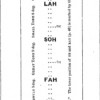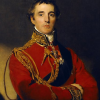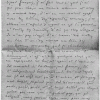
Phyllis Weliver, “On Tonic Sol-fa, January 1842”
In January 1842, John Curwen launched Tonic Sol-fa – a system for teaching people to sing, which he believed would improve individual and national morality. By the third quarter of the century, Tonic Sol-fa numbered hundreds of thousands of practitioners at home and in the colonies, and had outstripped competing sight-singing methods. This essay argues that Tonic Sol-fa promoted a way of managing behavior that worked alongside rational recreation and newly introduced institutional surveillance strategies.

Sean Grass, “On the Death of the Duke of Wellington, 14 September 1852”
This essay discusses the death of the Duke of Wellington on 14 September 1852, which is notable less for the fact or manner of his death than for the spectacular funeral that followed two months later, on 18 November. By the time of his death, Wellington was already a kind of living monument, a last grand hero of England’s bygone Romantic age. Consequently, and precisely because it followed on the heels of the Great Exhibition of 1851, Wellington’s death crystallized a pivotal cultural moment, when England’s Romantic past gave way finally and decisively to the pressures of commodity, celebrity, and spectacle that had been mounting for a half-century, and that would characterize the increasingly modern tone of Victorian England. First, this essay discusses the lavish arrangements for Wellington’s state funeral, then it attempts to describe the nation’s complex impulses simultaneously to mourn and commodify the great Duke. Finally the essay captures, as much as possible, the ways that Britons – from Queen Victoria to William Gladstone to Charles Dickens – responded to this moment, unlike any other in English history.

Carolyn Vellenga Berman, “On the Reform Act of 1832”
This entry examines a key moment for the British national imagination: the Great Reform Act of 1832 (or First Reform Act). It explores this crisis in aristocratic rule through the prisms of class, religion, geography, and the rise of the popular press, highlighting the concept of “representation of the people” enshrined by the act and the Age of Reform that it inaugurated.

Kate Lawson, “Personal Privacy, Letter Mail, and the Post Office Espionage Scandal, 1844”
The Post Office espionage scandal of 1844 began with the revelation that the British government, at the behest of the Austrians, had opened letters sent to the Italian nationalist Giuseppe Mazzini, then resident in London. This essay examines how letters themselves were represented in discussions of the scandal in parliament, the press, and other sources in June of that year. Two key attributes of letters were repeatedly identified, that letters were private and that letters contained secrets. The essay argues that these two claims about letters helped shape emerging definitions of privacy in personal communications and that the scandal raised questions about reasonable expectations of privacy that are at once Victorian and distinctly contemporary.

Ellen Malenas Ledoux, “Florizel and Perdita Affair, 1779-80”
This article examines the cultural and political significance of the Prince of Wales’s early 1780s involvement with Drury Lane actress and poet Mary Robinson. Rather than just a romance between two public figures, the “Florizel and Perdita Affair” had wide-ranging effects that, when examined, offer meaningful insight into everything from the weakening influence of the Hanover dynasty and the campaigns of Whig opposition candidates to the aesthetics of formal portraiture, political cartoons, and popular fashion.

Barbara Charlesworth Gelpi, “14 July 1833: John Keble’s Assize Sermon, National Apostasy”
This essay outlines the personal interactions and political events preceding John Keble’s delivery of a sermon later entitled National Apostasy to the judges gathered at Oxford for the Assize Court as a way of understanding the sermon’s significance in relation to the Oxford Movement.

Lisa Surridge, “On the Offenses Against the Person Act, 1828”
The early nineteenth century saw a new valuing of self-restraint and heightened social anxiety about interpersonal violence and unruly behaviour. The 1828 Offenses Against the Person Act streamlined penalties for assault, battery, rape, infanticide, attempted murder, manslaughter, and murder. It also granted to magistrates summary powers over common assaults, making prosecution of such offenses quicker and more accessible to the poor. Part of Sir Robert Peel’s larger program of legal reform, it heralded a new focus on social regulation, public order, and manliness as self-discipline.

Susan Hamilton, “On the Cruelty to Animals Act, 15 August 1876”
The Cruelty to Animals Act (15 August 1876) was the world’s first legislation to regulate the use and treatment of live animals in scientific research. This essay overviews the passage and provisions of the legislation, approaching the Cruelty to Animal Act as a site through which to examine the place of animals in clashes between an experimental medical science insisting on its professional and self-regulating status and animal welfare pressure groups that claimed a public right to shape the direction of medical science’s activities.

Mary Jean Corbett, “On Crawford v. Crawford and Dilke, 1886″
Crawford v. Crawford and Dilke was among the first Victorian divorce cases to involve a well-known English politician. It achieved scandalous status in its own time for both its lurid sexual details and its high-profile cast of characters. Focusing less on the chief male actors than its female participants, including Maye Dilke and Virginia Crawford, I consider the response by contemporary feminists to Sir Charles Dilke’s fall from power, as a consequence of his perceived transgressions, and some implications of the scandal for feminist politics in the 1880s and 1890s.

Mark Crosby, “The Bank Restriction Act (1797) and Banknote Forgery”
On 27 February 1797, the Bank of England suspended specie payments to preserve its dwindling bullion reserve. Less than three months later, William Pitt’s government shepherded legislation through Parliament codifying the suspension of specie payments. In place of specie, Bank of England notes became the circulating medium of currency. The smaller denomination notes, however, were very poorly produced and were copied with little difficulty and on an unprecedented scale. The governing statute for banknote forgery, which was a capital offense, did not distinguish between the production, distribution and/or handling of counterfeit notes, and hundreds of individuals were either executed or transported for unknowingly accepting and using forged banknotes. For many, the forcing of an easily imitated and alien paper currency on the population, coupled with the severe punishment designed to police this new circulating medium, was a flagrant manipulation of legislative power that prioritized commercial interests over human life.
